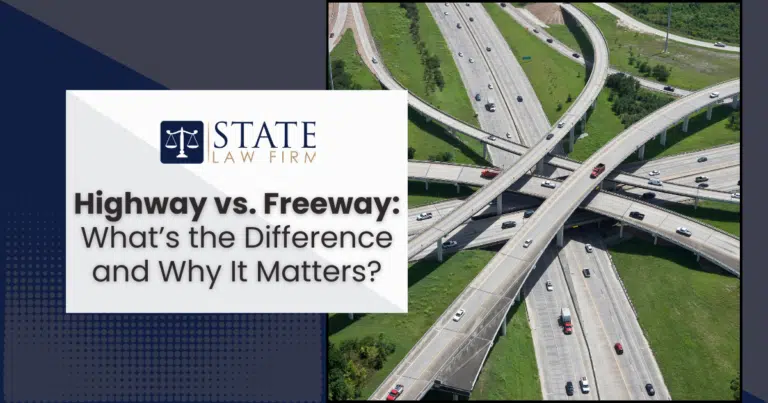When navigating the roads of California, especially in high-traffic areas like Los Angeles County, understanding the difference between a highway and a freeway isn’t just about semantics. It can affect your travel time, your safety, and in some cases, even your legal responsibilities as a driver. While these terms are often used interchangeably, they refer to distinct types of roadways with different designs, access points, and regulations.
This difference becomes even more critical when accidents occur. In 2022 alone, California recorded over 216,000 traffic-related injuries—many of them on high-speed roads like freeways and highways. Source: California Office of Traffic Safety. Knowing the road you’re driving on could impact how an accident is reported, how liability is assessed, and what legal options are available to you.
At State Law Firm, our car accident attorneys in Sherman Oaks are committed to helping victims understand their rights and navigate the legal road ahead, whether their collision occurred on a crowded urban freeway or a rural two-lane highway. As a boutique personal injury firm run by young and passionate attorneys, we’re here to not only advocate but also educate.
In this article, we’ll break down the key differences between highways and freeways, why these distinctions matter, and how understanding them can help you stay safer and more informed behind the wheel.
Understanding the Basics: Definitions of Highway and Freeway
Let’s start with the basics. What exactly is the difference between a highway and a freeway?
- Highway: A highway is a general term for any public road that connects towns or cities. Highways can include intersections, stoplights, pedestrian crossings, and direct access to properties or businesses.
- Freeway: A freeway is a specific type of highway that has fully controlled access. That means no stoplights, intersections, or driveways. Entry and exit are managed through ramps and interchanges only.
In short, all freeways are highways, but not all highways are freeways.
Pro Tip: If you’re driving on US-101, which stretches from downtown Los Angeles to the Oregon border, parts of it function as a freeway, especially through urban areas. Other stretches, such as those along the Central Coast, behave more like traditional highways. Recognizing this can help you anticipate speed changes and traffic flow.
The Key Differences Between Highways and Freeways
When you’re driving, here’s how these two road types actually differ:
| Feature | Highway | Freeway |
| Access Points | May include intersections and stoplights | Only accessible via ramps |
| Traffic Flow | Can be interrupted by signals or driveways | Designed for uninterrupted flow |
| Speed Limits | Often lower and more variable | Typically 65–75 mph in California |
| Toll Roads | Common on highways and some expressways | May include managed toll lanes |
| Pedestrian Access | Sometimes allowed, especially in rural areas | Not allowed at all |
For instance, California State Route 89, also known as the 10th Mountain Division Memorial Highway, runs through Tahoe City and Truckee. Although scenic and important, some segments include at-grade crossings, lower speeds, and varied road conditions. That makes it quite different from a nearby interstate freeway like I-80.
The Importance of Knowing the Difference for Drivers
You might be wondering why this distinction really matters.
- Navigation: Freeways are usually faster but have fewer access points. If you need to make frequent stops, a highway may be more practical.
- Legal Implications: Traffic violations can have different consequences depending on whether they occur on a highway or freeway. Freeway collisions often involve higher speeds and may result in more severe injuries or legal liability.
- Safety: Statistically, freeways see fewer accidents because there is no cross traffic or pedestrian interference. However, when collisions do occur, they tend to be more severe due to higher speeds.
If you’ve been injured on any California roadway, the car accident attorneys at State Law Firm in Sherman Oaks are here to help. We understand the nuances of roadway design and how they impact liability in personal injury cases.
Regional Variations: How Highway and Freeway Definitions Can Change by Location
Even within California, the use of the terms highway and freeway can vary:
- In Southern California, people often refer to roads by number and article, such as “the 405” or “the 10.” These typically describe freeways.
- In Northern California, locals might say “Highway 101” even when referring to what is technically a freeway.
- In other states, similar roads might be called expressways, turnpikes, or thruways.
This can lead to confusion for out-of-state drivers. For example, New York’s freeways may include toll barriers, while in California, routes like SR-73 or I-15 can include tolled express lanes or managed lanes.
The Future of Highways and Freeways: Trends in Road Infrastructure Development
California is currently investing in roadways that are safer, smarter, and more sustainable.
- Smart Highway Technology: These include sensors, adaptive speed signage, and real-time traffic updates.
- Sustainable Development: Projects such as the Farm-to-Fork Corridor on State Route 99 aim to boost economic development and reduce environmental impact.
- Urban Planning Integration: Cities like Los Angeles are exploring how to reduce the impact of freeways that cut through residential communities and increase pollution.
Pro Tip: Keep track of roadway updates in your area. Changes to toll zones, interchanges, or HOV lanes can affect your commute and your rights if an accident happens.
Whether you’re traveling along I-5 or navigating the curves of Highway 1, understanding the type of road you’re on helps you stay safe, plan effectively, and make smart decisions if something goes wrong. And if it does, you can count on the young litigators at State Law Firm to guide you every step of the way.
Would you like help turning this into a downloadable guide or companion piece for Southern California drivers?
FAQ
What is an interstate, and how is it different from a freeway or highway?
An interstate is part of the U.S. Interstate Highway System, built to federal standards for long-distance travel. In California, most interstates function as freeways, but not all highways are interstates.
What is an expressway?
An expressway is a divided highway with partial access control. It can include at-grade intersections, so it is not as restricted as a freeway.
Which is safer, a highway or a freeway?
Freeways generally have fewer conflict points and lower crash rates per mile traveled because there is no cross traffic. Crashes that do occur can be more severe due to higher speeds.
Can pedestrians or bicycles use freeways in California?
Pedestrians are not permitted on freeways. Bicycles are generally prohibited except on limited rural segments where signs explicitly allow them.
Do speed limits differ on highways and freeways in California?
Freeways typically post 65 to 70 mph for passenger vehicles unless otherwise marked. Highway limits vary more and can be lower due to intersections, signals, and roadside access.


